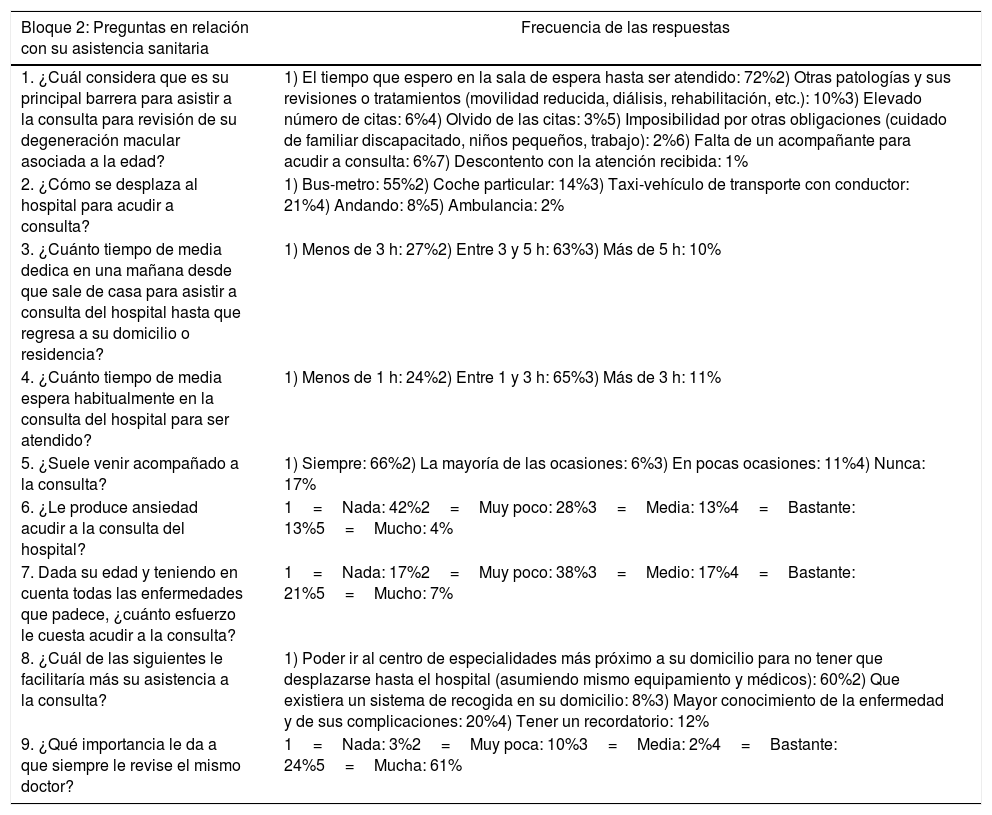Evaluar la percepción de las barreras en la asistencia sanitaria y del impacto de las inyecciones intravítreas en los pacientes con degeneración macular asociada a la edad neovascular (DMAEn).
MétodosEstudio transversal de 108 pacientes con DMAEn en tratamiento con inyecciones intravítreas mediante un cuestionario de 26 preguntas (puntuación del 1 al 5) divididas en 3 bloques: 1)enfermedad y su tratamiento con inyecciones; 2)barreras en la asistencia sanitaria, y 3)nuevas tecnologías.
ResultadosLa edad media fue 80,4±7,0 años y la agudeza visual (AV) de 75,2±12,4 letras. Las principales barreras en la asistencia sanitaria fueron los largos tiempos de espera en consulta (72%), seguida por otras comorbilidades (10%). El 63% de los pacientes dedican entre 3 y 5h para acudir a la consulta. Se apreció una ansiedad notable debida a las inyecciones (2,8±1,3), estando presente en el 71% el día antes. Se observó un gran miedo a la ceguera y a dejar de ser independientes (4,4±0,9 y 4,3±1,1), sin existir diferencias en relación con la AV, la edad o el sexo (p≥0,135). El 28% de los pacientes refieren que les cuesta bastante o mucho la asistencia a consulta, presentando el 69% del total un gran interés en tener un aparato diagnóstico en el domicilio.
ConclusionesLa DMAEn y su tratamiento suponen una importante carga asistencial para los pacientes, existiendo un gran miedo a la ceguera y a perder su independencia, siendo la principal barrera el largo tiempo de espera en consulta.
To evaluate the perception of barriers in healthcare and the impact of intravitreal injections in patients with neovascular age-related macular degeneration (nAMD).
MethodsCross-sectional study including 108 patients with nAMD in treatment with intravitreal injections. The patients answered a questionnaire with 26 questions (score from 1 to 5) divided in three sections: 1)the disease and its treatment with injections; 2)healthcare barriers, and 3)new technologies.
ResultsThe mean age was 80.4±7.0 years and visual acuity (VA) was 75.2±12.4 letters. The main barriers in healthcare were long waiting times (72%), followed by other comorbidities (10%). Some 63% of patients have to wait between 3 and 5hours to attend their clinical visit. Significant anxiety due to the injections (2.8±1.3) was observed, being present in 71% of the cases the day before. A great fear of blindness and losing independence was observed (4.4±0.9 and 4.3±1.1), with no differences in relation to VA, age or sex (P≥.135). Moreover, 28% of the patients reported that it was quite or very difficult for them to attend the clinical visit, with 69% of the total showing great interest in having a diagnostic device at home.
ConclusionThe nAMD and its treatment represent a significant burden on patients, among whom there is a great fear of blindness and of losing their independence, the main barrier being the long waiting time for the clinical visit.
Artículo
Comprando el artículo el PDF del mismo podrá ser descargado
Precio 19,34 €
Comprar ahora









